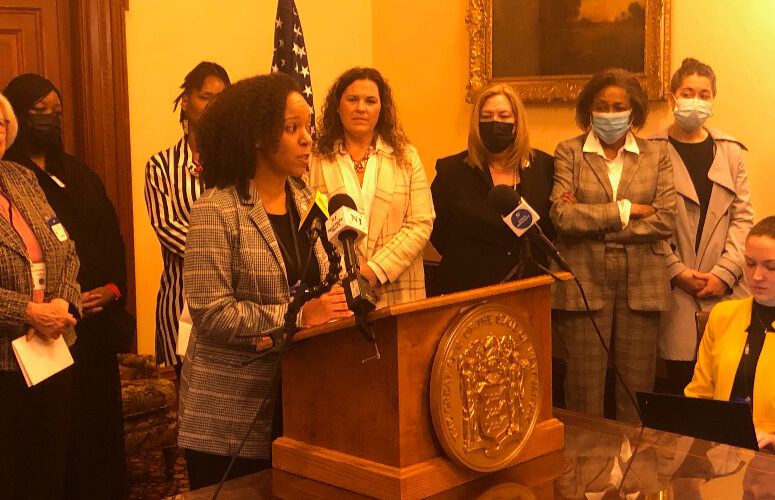
One State, One Goal
Healthy Moms and Babies
By Melinda Caliendo On Apr 3, 2019New Jersey’s labor and delivery hospitals are banding together to address one of the most pressing health issues in the state: maternal mortality. All 49 hospitals in the state that provide delivery services have engaged in the New Jersey Perinatal Quality Collaborative (NJPQC), one of 13 Centers for Disease Control-funded organizations dedicated to improving care for mothers and babies.
In New Jersey, pregnancy-related deaths occur in 37 of every 100,000 live births. The CDC defines a maternal death as any that occur within one year of the end of a pregnancy, no matter the outcome or duration of the pregnancy. For black mothers, the rate is even higher.
Around the state, efforts to identify and remedy the causes for maternal mortality have been initiated by First Lady Tammy Murphy through her Nurture NJ awareness campaign; by the Department of Health through its “Healthy Women, Healthy Families” strategic grant initiatives; by state lawmakers introducing packages of bills to improve care; and by community groups working with their neighbors.
“We need strong champions across the continuum of healthcare – from preconception and prenatal care to post-partum follow-ups – to ensure that all mothers and babies have an equal opportunity for good health. We know it demands a broad and coordinated effort by public health officials, hospitals, primary care providers and other healthcare stakeholders,” says Cathy Bennett, president and CEO of the New Jersey Hospital Association (NJHA). “We also need to educate and empower women and their support systems to be an active part of their healthcare so that their worries and concerns are recognized and acted upon.”
NJPQC has convened hospitals from around the state to work on maternal care challenges that specifically occur during a mom’s stay in the hospital: safely reducing the number of unnecessary C-sections for low-risk, first-time mothers; better identifying and treating hemorrhage and high-blood pressure, which are leading causes of maternal death; and reducing racial disparities in maternal care.
NJPQC is led by the NJHA’s Health Research and Educational Trust, and its Steering Committee is chaired by Andrew Rubenstein, MD, Hackensack Meridian Health and Hackensack University Medical Center section chief of obstetrics.
“I am proud of our 49 obstetrical hospitals’ leaders in the state of New Jersey with their 100 percent engagement in the mission and vision of the NJPQC. There are no other states within the PQC that have this level of hospital administrative support. This speaks so highly for their level of commitment to maternal health and perinatal safety,” Dr. Rubenstein says. “We are in the position for New Jersey to become the safest place in the world to deliver a baby.”
Dr. Rubenstein explains that NJPQC is taking lessons learned from other states – most notably California – that have been successful in driving improvements in maternal-child health. These evidence-based improvement processes include eliminating variation in how patients are treated, which sounds simple but requires both individual physicians and entire departments to make cultural and procedural changes.
Suzanne Spernal, DNP, APN-BC, is the vice president of women’s services for the RWJBarnabas Health system and the clinical lead for NJPQC’s work reducing first-time cesarean sections for low-risk, single-baby births, called Nulliparous Term Singleton Vertex (NTSV). NJPQC is working to reduce NTSV C-sections by 10 percent by the end of 2019.
Approximately 90 percent of women who have a C-section for their first delivery are likely to deliver by cesarean again in subsequent pregnancies, which progressively increases risks of complications such as hemorrhage and infection with each additional surgical delivery.
Spernal, who was part of the leadership team at Monmouth Medical Center that oversaw a NTSV C-section reduction project, says reviewing patient charts to find out where variations were occurring led to specific ways to improve care.
“What we did are the things that we’re supporting and encouraging through the PQC. We did chart reviews to develop a diagnosis baseline to see what bucket the majority of our NTSV C-sections were falling in,” Spernal explains. “And then we implemented initiatives or interventions to try to support the docs in their decision-making so that a vaginal delivery was more likely the outcome.”
Another way Monmouth Medical Center reduces the likelihood of a first-time, low-risk mother delivering surgically is by implementing a laborist group; a board-certified physician is at the hospital 24 hours-a-day, seven days-a-week to support attending physicians. They found that newer doctors are supported by more experienced physicians when making decisions about when a C-section is needed.
“Some of the C-sections were done for all of the right reasons,” Spernal says. “It wasn’t that anyone was doing anything wrong, it was just an opportunity to improve and make practice changes.”
Dr. Rubenstein also echoes that having data from the state’s hospitals will offer opportunities to pinpoint the unique factors in each community that lead to maternal mortality, as well as implement readiness protocols to ensure each mother gets the same level of treatment whether she is at a large system-affiliated hospital or a small community hospital.
No matter where a new mother goes to deliver her baby, her care team should have the same readiness, recognition and response for complications like hemorrhage or hypertension (high blood pressure), according to evidence-based practices. That’s why NJPQC is implementing the Alliance for Innovation in Maternal Health (AIM) program, developed by the American College of Obstetricians and Gynecologists and using tools developed by the California Maternal Quality Care Collaborative.
Research has shown that maternal deaths from obstetric hemorrhage and severe hypertension are often associated with gaps in communication, difficulty in recognizing the conditions, delayed intervention and ineffective treatment strategies, all of which can be prevented. AIM uses standardized “bundles” of actions to identify and address these complications in pregnancy and delivery.
Nationally, not every hospital has advanced resources like a round-the-clock pharmacy or blood bank on site, Dr. Rubenstein explained. “But every hospital needs to have the same basic care and accountability.”
Throughout all of its work, NJPQC is incorporating health equity as a lens to view progress. Spernal says that breaking out health data by race and ethnicity in progress reports will begin to reflexively incorporate addressing disparities into every conversation and process.
“In order to improve outcomes and eliminate these disparities, you do what we’re trying to accomplish through NJPQC; implementing evidence-based strategies – supported by all of our professional organizations – and by evaluating improvement in quality and safety by using data-driven approaches,” Spernal says.
She adds that utilizing shared decision making, “with mom as the team captain,” plays an important role in equity of care and patient experience and outcomes.
Both Spernal and Dr. Rubenstein commend the Murphy Administration for raising awareness of the racial disparities in maternal mortality, saying that until recently it was not part of the conversation on maternal-child health.
They also commend the leadership buy-in from hospitals around the state to provide the support and resources necessary for frontline providers to improve patient care.
“We’re really trying to drive change and we have a core group of people in the PQC who can make it happen. This is the power of the Perinatal Quality Collaborative,” Dr. Rubenstein says.
To access more business news, visit NJB News Now.
Related Articles:





